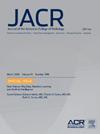State-Level Medicaid Reimbursement and Imaging Utilization by Medicaid and Children’s Health Insurance Program Patients
IF 4
3区 医学
Q1 RADIOLOGY, NUCLEAR MEDICINE & MEDICAL IMAGING
引用次数: 0
Abstract
Purpose
To determine if relative Medicaid-to-Medicare reimbursement rates are associated with patient imaging utilization.
Methods
This cross-sectional study estimated the association of diagnostic imaging utilization with the state-level Medicaid-to-Medicare reimbursement ratio (MMRR) of professional payments. State-specific reimbursement ratios were computed for each imaging modality. Logistic regression was used to estimate the likelihood of having imaging, and gamma regression was used to estimate the average number of imaging studies for those with imaging. These models were performed for each gender-modality combination controlling for patient characteristics.
Results
Among 48,835,765 Medicaid patients, 54.3% were women. The median MMRR was 0.82 (interquartile range [IQR]: 0.73-0.94) for CT, 0.87 (IQR: 0.76-1.01) for MR, 0.76 (IQR: 0.69-0.99) for nuclear medicine (NM), 0.85 (IQR: 0.73-1.09) for ultrasound, and 0.82 (IQR: 0.74-0.97) for radiography or fluoroscopy (XR). The probability of having imaging was 25.9% for CT, 25.9% for MR, 21.4% for ultrasound, and 31.8% for XR higher at 75th percentile of the MMRR distribution compared with the 25th percentile (P < .001). For those with imaging, the mean number of imaging studies received was associated with 5.7% fewer studies for NM at the 75th percentile compared with the 25th percentile (P < .001), although there was no difference for other modalities.
Conclusions
Medicaid payments are related to imaging utilization. A higher MMRR is associated with a substantially increased likelihood of Medicaid patients receiving CT, MR, ultrasound, and XR imaging but no difference in the amount of imaging studies received for those with imaging for these modalities.
医疗补助和儿童健康保险计划患者的州级医疗补助报销和成像利用。
目的:确定相对医疗补助-医疗保险报销率是否与患者影像利用相关。方法:本横断面研究估计诊断成像利用与国家级医疗补助-医疗保险报销比例(MMRR)的专业支付的关系。计算了每种成像方式的州特有报销比率。Logistic回归用于估计影像学检查的可能性,伽玛回归用于估计影像学检查的平均次数。这些模型是针对控制患者特征的每种性别模式组合进行的。结果:在48,835,765名医疗补助患者中,54.3%为女性。CT的中位MMRR为0.82(四分位间距[IQR]: 0.73-0.94), MR为0.87 (IQR: 0.76-1.01),核医学(NM)为0.76 (IQR: 0.69-0.99),超声为0.85 (IQR: 0.73-1.09), x线或透视(XR)为0.82 (IQR: 0.74-0.97)。在MMRR分布中,第75百分位的显像概率为25.9%,MR为25.9%,超声为21.4%,XR为31.8% (P < 0.001)。对于那些接受影像学检查的患者,与第25百分位数相比,接受影像学检查的平均次数与第75百分位数的NM研究减少5.7%相关(P < 0.001),尽管其他方式没有差异。结论:医疗补助支付与影像利用有关。较高的MMRR与医疗补助患者接受CT、MR、超声和XR成像的可能性显著增加有关,但接受这些方式成像的患者接受的成像研究数量没有差异。
本文章由计算机程序翻译,如有差异,请以英文原文为准。
求助全文
约1分钟内获得全文
求助全文
来源期刊

Journal of the American College of Radiology
RADIOLOGY, NUCLEAR MEDICINE & MEDICAL IMAGING-
CiteScore
6.30
自引率
8.90%
发文量
312
审稿时长
34 days
期刊介绍:
The official journal of the American College of Radiology, JACR informs its readers of timely, pertinent, and important topics affecting the practice of diagnostic radiologists, interventional radiologists, medical physicists, and radiation oncologists. In so doing, JACR improves their practices and helps optimize their role in the health care system. By providing a forum for informative, well-written articles on health policy, clinical practice, practice management, data science, and education, JACR engages readers in a dialogue that ultimately benefits patient care.
 求助内容:
求助内容: 应助结果提醒方式:
应助结果提醒方式:


